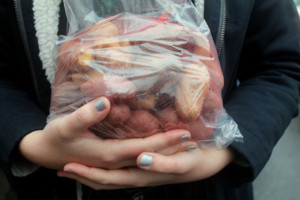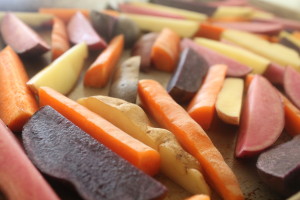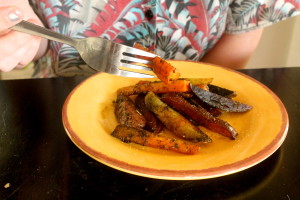
“There must have been a billion leaves on the land; he waded in them, a dry river smelling of hot cloves and warm dust. And the other smells! There was a smell like a cut potato from all the land, raw and cold and white from having the moon on it most of the night.” -Bradbury, Fahrenheit 451
It seems like it’s the same story every week. The fridge is empty. My crisper pleads with me to fill it’s drawers with fresh produce. Some stray garlic cloves hang around the back alleyways of the pantry, like bored teens waiting for something interesting to happen. Yet despite the bleak condition of my food stores, I insist on stoically (or bullheadedly, depending on who you ask) waiting out those few days until a bright Saturday morning when white tents crowd the streets as linen covered heralds of our local farmer’s market.
Starch is where the heart is.
The day finally arrives and I gear up with what can only be described as an arsenal of cloth bags, ready for the heaviest of squashes or the most dainty maché. After a brisk walk down the street and around the corner, my eyes light up in excitement and I can feel my mouth begin to water in anticipation of recipes to come. While winter may be cruel with its sparse selection of fruits and veggies, it’s also the time of year that produces one of my favorite tubers to cook with.
It’s sunchoke season.
Yet while I’m cooing over their cute little knobs and imagining slicing into a steaming tray piled high in nutty sunchoke-goodness, my friends are eyeing these malformed lumps with extreme skepticism. “What exactly is a sunchoke? It certainly doesn’t look like an artichoke,” they challenge with narrowed eyes. I smile at their naiveté and throw a handful in my bag, “no, it’s not an artichoke,” I toss a few more in for good measure, “it’s better.”
Anthocyanins make me smile too.
Of course, I could have just told them right off the bat that sunchokes are in fact closely related to artichokes, as they both belong to the Asteraceae family. I could have told them that despite the myth that all white vegetables must be devoid of nutrition, sunchokes contain phenolic compounds which promote healthy cell regulation and protect against cancer. I could have told them that sunchokes, like garlic, also contains inulin which encourages the growth of beneficial gut bacteria, thus increasing immunity and aiding in metabolism.
Phenolicious!
I could have told them all of these things and more, but isn’t science so much more fun when you have warm and intoxicating smells drifting out of your oven? I am a strong believer in food for thought! On that note, in addition to my haul of sunchokes I picked up some purple majesty and mountain rose potatoes; gorgeously hued tubers (what’s a tuber, you ask? The scientifically accurate name for those so-called “roots” that you frequently eat, that’s what!) that because of their pretty colors my friends seemed equally nervous to cook with.
Cooking with Kuli wouldn’t be complete without moringa.
I have good news! The compounds that make these potatoes pink and purple are only beneficial to your health. They’re called anthocyanins, and they belong to one of the four families of plant pigments. There are over 300 known anthocyanins, and each fruit or vegetable you eat may contain a dozen of them or more. Anthocyanins are an extremely valuable and natural source of antioxidants. Harold McGee writes that, “the more pigmented and astringent [a fruit or vegetable is], the more likely it is to be rich in phenolic antioxidants.” If that hasn’t sold you already, sunchokes are also a great source of B vitamins, iron, and potassium!
Are you hungry yet? Let’s get cooking!
Sunshine Roast
Prep Time: 10 minutes
Cook Time: 30-40 minutes
Servings: 3-4, depending on how much you eat
Ingredients:
- 2 lbs of your favorite tubers, I used a mix of sunchokes, mountain rose, and purple majesty, but a classic russet works just fine
- 2 large carrots
- 5 garlic cloves or more, I come from the school of thought where you can really never use too much garlic
- Oil of choice, I used canola but olive is lovely as well
- Paprika
- Italian herb mix, if you don’t have this any combination of rosemary, thyme, sage, and oregano works
- Moringa
- Salt and pepper to taste
Directions
Heat oven to 400 degrees F.
Cut your potatoes lengthwise, and then lengthwise again so that they are even strips about a 1/2 inch in thickness. The thinner you cut them, the crispier they will get. Cut your carrots in half, and then cut them the same way as you did with the potatoes, so that they will be of similar sizes. Smoosh the garlic a little with the side of your knife to remove their paper, and slice them into quarters.
Evenly spread everything on a baking sheet, and coat generously with oil. You don’t want them to be swimming in oil, but they should all be good and shiny after a stir or two. Coat them with an even layer of paprika, then stir. Repeat with moringa, Italian spices, salt, and pepper. Don’t be shy with your spices. Trust me, you really can’t spice something too much. The biggest tragedy is an under-spiced potato; it’s just wrong, I tell you!
Give your potatoes one last stir, making sure that they are all in one, even layer on the pan, and then pop those suckers in the oven! Set your timer for 30 minutes, stirring them every 10 minutes. Depending on your oven’s temperature, you may need to cook them for an extra 10 minutes. Just try one after the first 30 minutes and if it doesn’t send you straight to potato heaven then give it a little more time.
That’s all there is to it! Not so scary anymore, right?
“The senses are the organs by which man communicates with the world outside himself” -Brillat-Savarin, The Physiology of Taste
You can find many more yummy moringa recipes on our blog!
Sources:
McGee, Harold. On Food and Cooking. New York: Scribner, 2004. print.

















